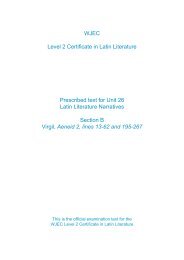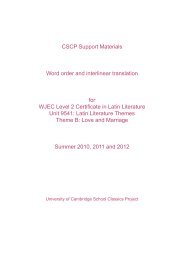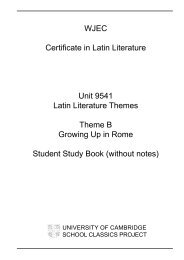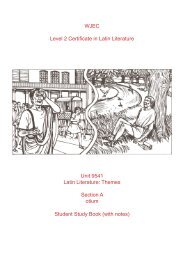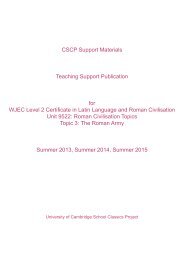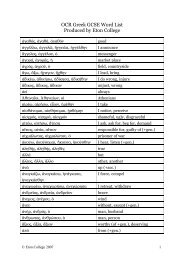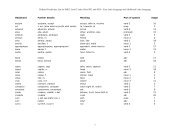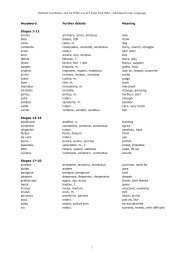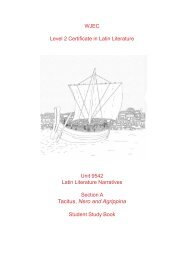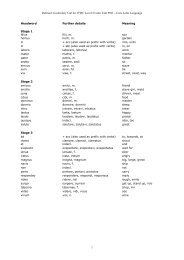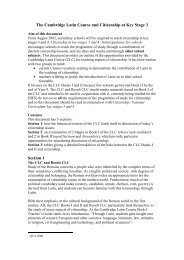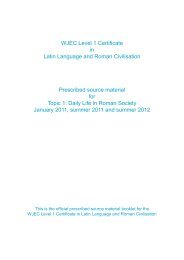2. Student Study Book - Cambridge School Classics Project
2. Student Study Book - Cambridge School Classics Project
2. Student Study Book - Cambridge School Classics Project
Create successful ePaper yourself
Turn your PDF publications into a flip-book with our unique Google optimized e-Paper software.
21. Read lines 5-10 (aloud if possible) or listen to the audio on the CSCP website.2<strong>2.</strong> <strong>Study</strong> the vocabulary.23. Read lines 5-10 (or listen to the audio) again.24. What is worn away or eaten away in line 5? Find the adjective that describes it. Is the adjective especiallyrelevant to the point Ovid is making? If so, how?25. What wears it away?26. What is ruined or worn out in line 6? Find the adjective that describes it. Which adjective-and-noun phraseexplains why it gets worn out?27. In lines 5-6, how does Ovid emphasise the idea of never stopping? If puzzled, look at the words in lines 3-4which emphasise the idea in a similar way.CheckCheck28. What is the point of adsidua in line 6?(a) The contact between ploughshare and ground goes on throughout the ploughing.(b) Ploughing is repeated every year.(c) Both (a) and (b) are true.29. Translate line 6. adsidua … humo is harder to translate than adsiduo … usu in line 5, and you may need toinclude a phrase like “contact with”.30. Latin writers sometimes use the ablative instead of quam to make a comparison. Before proceeding to line 7,translate these two examples; they both have the same translation:Sextus est altior quam Marcus = Sextus est altior Marco.Two more examples:(i) elephantus est maior equo.(ii) hoc templum est pulchrius quam illud.If you are not clear why pulchrius is used and not pulchrior, see the <strong>Cambridge</strong> Latin Grammar, foot of page 16.31. What two questions does Ovid ask in line 7?3<strong>2.</strong> What does he imply is the answer to both questions?33. In line 8, which adjective describes saxa? Which describes aqua?34. What happens to the rocks, in spite of what Ovid said in line 7?35. Memory test: try to answer this without looking back:In line 9, which important word in this extract appears now for the third time?36. The Greek letter nu (equivalent to English n), when used at the end of a word, often indicates the accusativecase. (Which letter does the same job in Latin?)37. Who was Penelope (line 9), and for what quality was she particularly famous?38. vincere is a 3rd-conjugation verb. What is the tense of vinces? If necessary, check in the <strong>Cambridge</strong> LatinGrammar, page 28, paragraph 1. What person (“I”, “you”, etc.) is it?39. What does Ovid predict that his reader or listener will achieve in time? (Hint: ignore persta modo for the moment.)40. What must the reader or listener do to achieve this result? You may find it helpful to translate modo (only)before you translate persta.41. Which word describing Penelope emphasises that she is an extreme example? Which of these descriptionspresents the traditional picture of her qualities, and which description looks at the same qualities from Ovid’svery different point of view?(a) The toughest challenge of the lot.(b) A perfect model of a faithful wife.In (a), to whom would she be a challenge?42* If you look up the story of Penelope you will see there is room to disagree over whether she is a good examplefrom Ovid’s point of view. You could say “she was going to give in, because she promised to marry the winnerof a contest”. On the other hand you could say “but in fact she didn’t marry anyone, and she deserves praise forholding out for twenty years”. So is she a good example for Ovid’s argument or not?43. What famous city does Ovid mention in line 10, referring to it by the name of its highest and most heavilyfortifiedarea? What does he say happened to it, and when? According to the traditional story, how long a timeis indicated by sero?WJEC Level 2 Latin Literature Unit 9541 Love and Marriage 69



